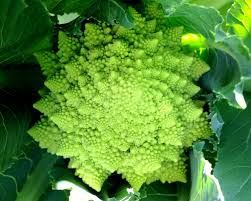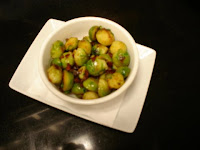 |
| Roman broccoli, cauliflower, and Roman specialty puntarelle (cleaned chicory stems) in the market in Rome. |
But the cold outside doesn't mean we can't enjoy some wonderful produce -- and specifically, winter vegetables -- indoors in our kitchens. There's beauty in their variety of flavor but also in their shapes, sizes, colors, and uses. It's never been easier to "eat the rainbow" of colors in vegetables alone, and many of these items are hearty enough to make into a soup, to pair with the rich meat stews of the season, or to skip the meat altogether and enjoy these gifts of nature on their own as a substantial, diet- and environment-friendly alternative to animal proteins. Below are some great options, as well as some ideas as to what to do with these wonderful winter veggies:
- Radicchio tardivo: This elegant, elongated variety of radicchio di Treviso comes from northeastern Italy around the town of Treviso in the Veneto. It has slim leaves that are white and tipped with burgundy, a result of a second "forced" growth process when the harvested heads are placed in growing tanks with flowing water for a second growth; they're then harvested late (hence "tardivo"). Their crisp, bitter leaves are a thing of beauty, and work especially well in dishes of the area, like a risotto or pasta with radicchio, gorgonzola, and walnuts. This veg is great grilled, or oven-roasted with a little balsamic and a sprinkling of sugar to take away the bitter edge. It's also great in a winter salad with endive and perhaps some kale or watercress.
 - Celery root, or Celeriac: This is quite literally the root of celery, but as a root vegetable it's got a bit of starch to it. You can slice into matchsticks to enjoy raw in a salad, or cook it with a potato or two to make a healthier, lower-carb version of mashed potatoes
- Celery root, or Celeriac: This is quite literally the root of celery, but as a root vegetable it's got a bit of starch to it. You can slice into matchsticks to enjoy raw in a salad, or cook it with a potato or two to make a healthier, lower-carb version of mashed potatoes (trick: the lack of gluten in the celeriac makes its substitution for mashed taters a great healthy upgrade, and you can put it in a food processor for a smooth puree without the gummy mess of potatoes alone). This also means it makes a fabulous soup -- it's great comfort food in cold weather, especially with some fried leeks and a drizzle of maple syrup on top.
- Cauliflower: Much has been made lately of the previously-lowly, pale head of cauliflower, and with good reason. This pallid cruciferous vegetable is actually really healthy for us, and is incredibly versatile. Cook the florets as is traditional and you can toss them with pasta, pine nuts, and raisins in olive oil with a splash of wine and you have a great pasta dish, Sicilian in origin. Pulse in a food processor and you have gluten-free couscous. Roast whole in the oven rubbed with olive oil, salt, and spices, and you have an excellent main course meat stand-in (You can also slice the cauliflower into "steaks" and serve vegetarian versions of steak preparations: cauliflower au poivre, anyone?).
- Broccolo romano, or Romanesco: This is what Romans refer to simply as a "broccolo" -- they think the dark green version that is our standard is "broccolo siciliano" (Sicilian broccoli). This is a popular side dish in Rome, cooked until meltingly tender in olive oil, with garlic and peperoncino. Mammamia! It's also tossed with pasta, and served in the disappearing-but-traditional Roman soup, broccoli ed arzilla made with stingray and roman broccoli in broth -- really delicious.
- Winter squash: This family includes butternut, spaghetti, acorn, delicata, and on and on. Roasted with just a drizzle of olive oil, a few cloves of garlic, and a sprinkling of sea salt, winter squash are healthful and a great substitute for potatoes alongside proteins. They can be pureed into amazing soups. They can be roasted alongside other vegetables. They can become filling for pastas like ravioli. Spaghetti squash can be served like its namesake pasta, in place of the pasta itself! And delicata squash can be served skin-on, for extra ease in prep...and extra fiber. These nubby veggies are versatile and amazingly delicious, and even the seeds should be saved, cleaned, and roasted to make into a healthy snack, to sprinkle on salads, to grind into a pesto...even to candy for dessert!
- Brussels sprouts: These mini-cabbages named after a Northern European city (still a mystery) have caught on again since the "new" century, and have become a ubiquitous side dish in restaurants from Manhattan to Minneapolis. And good for them! Because they're very good for us, another cruciferous veggie full of fiber and vitamins. I make mine with pancetta, shallots, balsamic or sherry vinegar, and a touch of honey -- and they're a perennial Thanksgiving favorite.
- Cabbage: Big brother to the brussels sprouts above, cabbage is another healthful, incredibly versatile veg. There are many varieties, including regular green or white cabbage, red cabbage, and savoy cabbage with its slightly curlier, thinner leaves. Cabbage can be shredded and eaten raw, as in cole slaw, or cooked, as in stewed cabbage (I like mine sweet-and-sour, like they make it in central Europe, stewed with some vinegar, salt and sugar). It can be fermented and transformed into kimchi, or simply eaten as part of a salad. It can be stuffed with ground meat or vegetables and stewed for stuffed cabbage or other savory packets or spring rolls. It's also great in a simple soup with a veggie broth, brightened with the acidity of a splash of vinegar.
 - Beets: Another underdog root veggie we root for (food pun!), the beet was and is still "having a moment" on menus across America. These former outcasts have experienced a renaissance, and I'm happy about that, because they're gorgeous and packed full of vitamins and antioxidants, and they make a great soup (borscht), a great salad ingredient, and a great side dish.
- Beets: Another underdog root veggie we root for (food pun!), the beet was and is still "having a moment" on menus across America. These former outcasts have experienced a renaissance, and I'm happy about that, because they're gorgeous and packed full of vitamins and antioxidants, and they make a great soup (borscht), a great salad ingredient, and a great side dish. 
They're a substitute for the deep ruby color of raw beef, so vegan tartares now have new life. They can be golden or fuchsia or swirly candy-cane colored (chioggia beets), they can be sliced thinly or fried into chips or served julienned in a salad with lots of carrots and pistachios and fresh herbs and warm spices like cumin and ras-el-hanout...They pair really well with those carrots, but also with goat cheese and ricotta cheese, with nuts and herbs, they're great dressed with vinegars or with sweet-sour pomegranate molasses or silan date syrup for a Middle Eastern-North African vibe, and they're great in Central and Eastern European preparations, with dill and meat and potatoes and flaky smoked fish...they're as versatile as they are pretty, and as inexpensive health powerhouses, they can't be...well, you know...
Enjoy the healthy vegetable variety that comes with the winter season, and get your fill while you can!









No comments:
Post a Comment